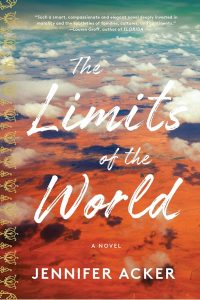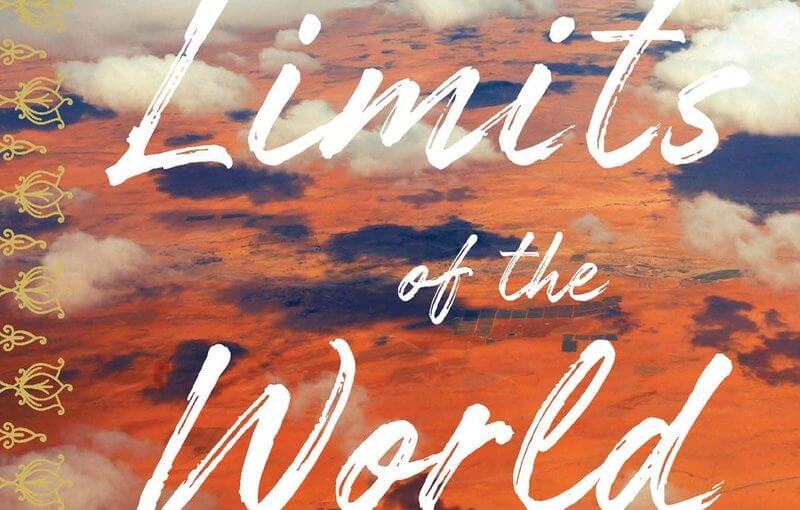Transcending Cultures and the Limits of Family
By DeWitt Henry, Prose Editor
THE LIMITS OF THE WORLD by Jennifer Acker (Delphinium Books, April 2019). 300 pp, $25.95.
 Jennifer Acker’s deeply considered and expansive novel focuses on love and family transcending races, cultures, religions, geography, and time, and calls to mind other recent cross-cultural novels (such as Preparation for the Next Life by Atticus Lish) as well as the international-themed novels of Henry James. Acker’s project, like theirs, serves to expand the horizons of American readers for whom distant nations remain more “other” than familiar.
Jennifer Acker’s deeply considered and expansive novel focuses on love and family transcending races, cultures, religions, geography, and time, and calls to mind other recent cross-cultural novels (such as Preparation for the Next Life by Atticus Lish) as well as the international-themed novels of Henry James. Acker’s project, like theirs, serves to expand the horizons of American readers for whom distant nations remain more “other” than familiar.
In good Jamesian manner, her point of view characters include Urmila and Premchand Chandaria, Indians who have immigrated to Columbus, Ohio from Nairobi in 1965. They are twice transplanted, first as members of the multi-generational, close-knit Indian community in Nairobi, and now as Americans. Premchand is a doctor. Urmila attempts to run a gift shop devoted to African imports. Ostensibly, they have one son, Sunil, who has a Jewish-American girlfriend in defiance of family tradition, and who is struggling to finish a Harvard PhD in Philosophy. For thirty years, the parents have hidden the fact from Sunil that Bimal, whom he has only known as his cousin in Nairobi, is in fact his brother. As Urmila’s first, early pregnancy had been inopportune, she and her young husband had given Bimal to her sister instead of aborting.
All of Acker’s point of view characters are privileged, articulate, and intelligent. Amy, Sunil’s American wife, while denied a heroine role like Isabel Archer’s is nonetheless the American reader’s likeliest guide into the dynamic and culture of her husband’s family.
The plot’s inciting event is a call to Sunil in Cambridge from Urmila, who is visiting Nairobi on business. Bimal—his brother, she now insists—has been injured in a car accident. Sunil must join them at his bedside. In turn, Sunil announces that he has married Amy in Cambridge and will bring her along, despite his mother’s shock and objections (Amy’s religious parents in DC, too, have resisted the mixed race and faith union, but unlike Urmila, “they went from being angry to being concerned, invested, so quickly. They were still hurt, but they were a family…They weren’t going to decide that Amy was dead to them”).
Bimal heals, but Sunil’s discovery of their brotherhood isn’t the core story—far deeper issues are prompted much later by the random murder of Premchand by a revolutionary tribesman. How will the relatively close-minded Urmila react now that she is alone? Will she now accept Sunil’s marriage and independence? Will Sunil forgive her outburst in the throes of grief, when she mistook his voice for Bimal’s, her “heart”:
“No” said the voice, this cracking, mournful voice she did not recognize. “The other one.” No! not the one she wanted, she wanted the one who did not know her weaknesses, who would love her simply because she had given life, she wanted ease, and this one had never been ease, and never would be. And she was so tired. “You,” she said, crying “I don’t want you. You are not mine. Go now, and don’t come back.”
While trying to reconcile with Sunil afterwards, she reflects: “Why did she need to apologize when it was so obvious her grief had gotten the best of her? Of course she loved her son! With her whole heart, with a heart larger than her body.”
Acker through her characters’ perceptions gives us the American places of Cambridge/Harvard, Washington, DC, and Columbus (where Sunil grew up), but most fully establishes the worlds of Kenya and Nairobi, not just in terms of sensory impressions, landscapes, class, social tensions, and customs, but also of history. This last is offered through the device of transcribed tape recordings offered to the reader as occasional inter-chapters throughout. Toward the end, we learn that they were from Sunil’s grandfather—initially “a series of brief interviews…that Bimal had recorded for a college oral history project.” These serve to inform both his grandsons of the historical difficulties for “Asians” in Kenya, especially during and after the Mau Mau revolution that drove out the British:
You children, you don’t know how hard it is to build up something where before there was only bush…We traded with the Africans. We clothed their naked bodies and gave them the tools to become civilized….The British were enthusiastic about us in the beginning….[But] soon we outnumbered the whites. We could have squashed them if we were not a peaceful people. If we had in mind upheaval and casting out like the natives would do a few decades later…..We were between two fires. If we are nice to the natives, the whites think we are dangerous. If we are aloof, the natives say we are doing nothing to help their country….We held tight together, worshipped our own way….[During the Mau Mau terror in the 60s, Asians] were squeezed again between the Blacks and Whites. It is a surprise we are still Brown and not Gray!
Meanwhile Sunil and Amy try “to see things from a foreigner’s point of view.” They relate to the film and memoir, Out of Africa. They take a safari to a wild game park: “At first Sunil didn’t see anything, his eyes not discerning among the sprouting trees and branches, the encompassing bunches of leaves, until, all of a sudden, it was there, again far larger than expected. It stretched dangerously across limbs. Fur sleek and spotted, its paws large as human skulls.” They visit a museum. Yet they learn through time and circumstance to see beyond exhibits, wonders, and stereotypes and into human complexities, including that of their own marriage and of both of their “outsider” heritages.
Acker’s fiction transcends the labored ethnographic approach of say Oscar Lewis’s La Vida, as well as the studied historical perspective offered by the Grandfather’s tapes. Like Sunil, the novelist seeks “to understand not the greater workings of the universe but the logic of human beings. A business so much messier than he had naively expected.” And as her fiction takes its measure of the Chandaria family’s crises, love and kind, its heart catches fire.
Copyright 2019 Woven Tale Press LLC. All Rights Reserved.

